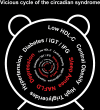The Circadian Syndrome: is the Metabolic Syndrome and much more!
- PMID: 31081577
- PMCID: PMC6851668
- DOI: 10.1111/joim.12924
The Circadian Syndrome: is the Metabolic Syndrome and much more!
Abstract
The Metabolic Syndrome is a cluster of cardio-metabolic risk factors and comorbidities conveying high risk of both cardiovascular disease and type 2 diabetes. It is responsible for huge socio-economic costs with its resulting morbidity and mortality in most countries. The underlying aetiology of this clustering has been the subject of much debate. More recently, significant interest has focussed on the involvement of the circadian system, a major regulator of almost every aspect of human health and metabolism. The Circadian Syndrome has now been implicated in several chronic diseases including type 2 diabetes and cardiovascular disease. There is now increasing evidence connecting disturbances in circadian rhythm with not only the key components of the Metabolic Syndrome but also its main comorbidities including sleep disturbances, depression, steatohepatitis and cognitive dysfunction. Based on this, we now propose that circadian disruption may be an important underlying aetiological factor for the Metabolic Syndrome and we suggest that it be renamed the 'Circadian Syndrome'. With the increased recognition of the 'Circadian Syndrome', circadian medicine, through the timing of exercise, light exposure, food consumption, dispensing of medications and sleep, is likely to play a much greater role in the maintenance of both individual and population health in the future.
Keywords: circadian clock; diabetes; metabolic syndrome.
© 2019 The Authors. Journal of Internal Medicine published by John Wiley & Sons Ltd on behalf of Association for Publication of The Journal of Internal Medicine.
Conflict of interest statement
The authors have no conflict of interests.
Figures
References
-
- Panda S. The arrival of circadian medicine. Nat Rev Endocrinol 2019; 1. - PubMed
Publication types
MeSH terms
LinkOut - more resources
Full Text Sources
Medical


